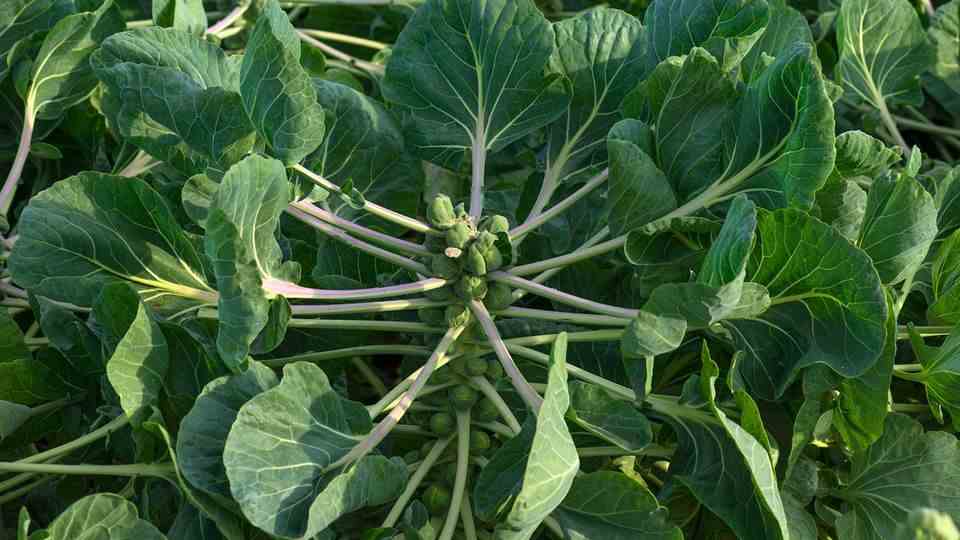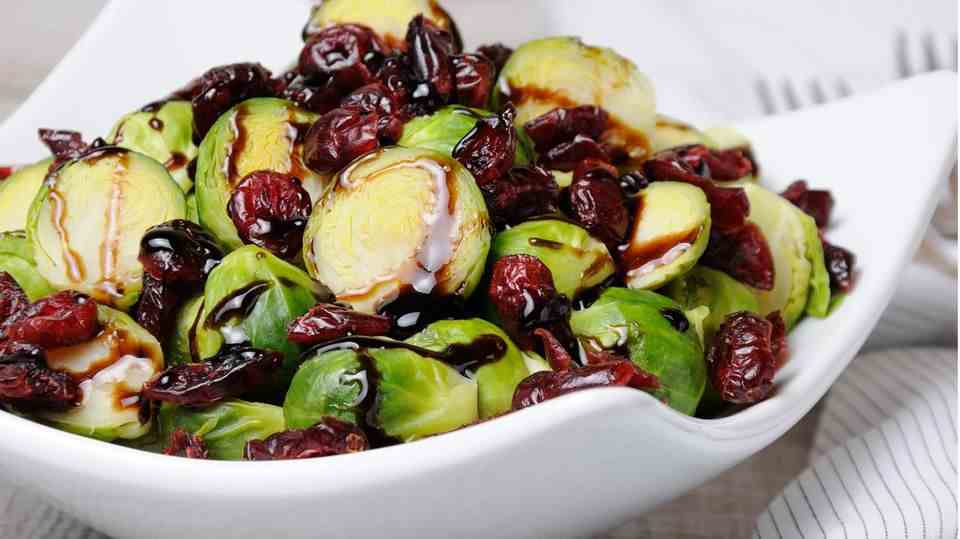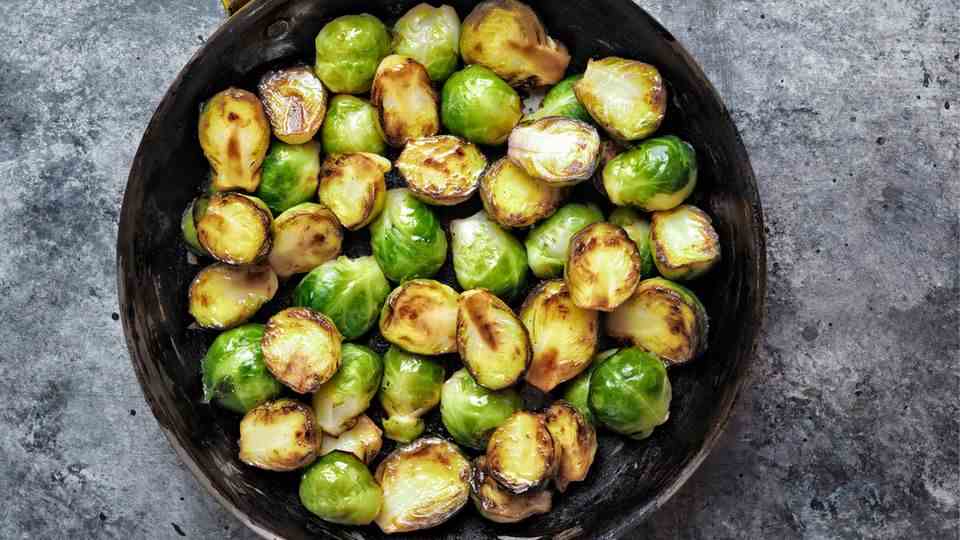winter vegetables
Brussels sprouts: How the unpopular vegetable side dish becomes a tasty main course
Pure Brussels sprouts, unseasoned and boiled in water until soft, hardly convinces anyone. The florets can be prepared in a variety of ways. Creative recipes can now be found on many food blogs and in veggie cookbooks.
© Westend61 / Imago Images
When I tell other people that Brussels sprouts are my favorite vegetable, I usually get incredulous looks. You only have to know a few tricks and recipes to turn the small, bitter bulbs into a delicious winter meal.
Brussels sprouts are not necessarily one of the most popular vegetables. Too many people associate bad memories with the green sprouts – like the soft-boiled, bitter Brussels sprouts that grandma served as a side dish. However, if you treat the winter vegetable as the main ingredient and give the controversial cabbage all your attention, you will find completely new ways of preparing it. Recipes that will convince even the biggest Brussels sprouts haters. This article provides three simple ideas. We also reveal why the green vegetables are so healthy and what needs to be considered when cooking so that grandma’s notorious version doesn’t end up on the plate.
History and taste of Brussels sprouts
Brussels sprouts come from Belgium and are therefore also known as Brussels cabbage (Brussel Sprouts in English). At the end of the 16th century, farmers from near the capital began cultivating the plant. What was then considered a “rare and unusable species” has been transformed into an edible vegetable thanks to painstaking breeding work. In the early 1800s, Brussels sprouts became popular as a winter vegetable across Europe and also spread to the United States. Today it is grown in North America and Central Europe, most commonly in France and the Netherlands: only 15 percent of the cabbage sold in Germany comes from domestic cultivation. Its season starts in October and ends in February, but supermarkets often still have the vegetables in their range in spring.
Although some taste buds claim the opposite, Brussels sprouts are attested to have a fine taste and only a slightly bitter note compared to other types of cabbage. That’s because the typically bitter note has been bred away since the 1990s. Newer breeds of the vegetable are therefore much milder than their predecessors. The taste is even more delicate after the first frost. This converts the starch it contains into sugar, so that the florets taste sweeter and are more digestible. This is usually the case from November or December.
Constituents of Brussels sprouts
The green tubers are a vegetable rich in nutrients and vitamins. 100 grams of Brussels sprouts contain 112 milligrams of vitamin C, which already covers the daily requirement. Vitamin C strengthens the immune system and can, for example, prevent influenza infections. Brussels sprouts also contain important B vitamins, beta-carotene, vitamin K and minerals such as potassium, zinc, iron, calcium and magnesium. Dietary fibers ensure a long-lasting feeling of satiety and support the metabolism by stimulating the production of digestive juices in the liver, gallbladder and pancreas.

The stalk of the Brussels sprouts plant can reach almost a meter in height. Up to a hundred florets grow on it.
© imagebroker / Imago Images
Glucosinolates also have a health-promoting effect. These are secondary plant substances that protect human cells from harmful radicals. This mechanism reduces the risk of developing certain types of cancer. Studies, for example from University of Vienna, have shown that regular consumption of Brussels sprouts can have a detoxifying effect and reduce the risk of cancer. The winter vegetables are also very low in calories. Just 36 calories and 0.3 grams of fat are in 100 grams.
Purchasing and storage of Brussels sprouts
When buying, you should make sure that the florets are tightly closed, have a strong, green color and a firm consistency. The outer leaves should be free of yellow discoloration. At home, you can store the vegetables in the fridge for up to a week. In no case should tomatoes or apples lie next to it. This is because they emit ripening gases, which cause the Brussels sprouts to spoil more quickly. When it comes to preparation, the vegetables should be washed. Outer, withered leaves and the stalk should be removed from the tubers.
Prepare and cook Brussels sprouts
Who the florets Cook should cut a cross at the base of the stem. This allows the Brussels sprouts to cook evenly. Then place the greens in a saucepan of boiling salted water or vegetable broth. Reduce the heat and simmer for a maximum of 10 to 15 minutes. It is better to cook Brussels sprouts for a shorter time than longer, otherwise the taste and some vital substances are lost – and the florets collapse (which brings us to Grandma’s Brussels sprouts).
Alternatively, you can also use the cabbage stew. Add just enough water to the pot to barely cover the florets. They then cook in their own juice, vitamins and taste are retained. Those who like the vegetables to be particularly al dente can use the small tubers blanch: Place in boiling water for three minutes and then cool under ice water for three minutes.
fantasy animals
Paprika and taubergine: Colorful vegetable birds are created from funny word games
Roast and bake Brussels sprouts
Brussels sprouts can also be prepared in a pan: Halve the florets, heat the oil, add the bulbs cut side down and cook for about five minutes on each side roast meat. If you like, you can deglaze the vegetables with wine, vegetable broth, etc. at the end. The florets become particularly crispy when you put them in the oven bakes. To do this, halve the tubers, marinate with oil and spices, place cut side down on the baking tray and bake for 30 minutes at 200 degrees, turning the florets halfway through the baking time. They’re done when they turn slightly brown on the outside.
Recipe one: Brussels sprouts sweet and Christmassy
Ingredients (for one serving):
- 250 grams Brussels sprouts, halved
- 2 tbsp olive oil
- 100 grams chestnuts, chopped (either pre-cooked and sealed or roasted yourself)
- 300 grams cranberry sauce (bought or made from 200 grams cranberries, 160 ml orange juice and 100 ml maple syrup)
Preparation:
- Heat oil in pan
- Add the Brussels sprouts, cut side down, and sear for five minutes on each side
- Mix in the chopped chestnuts and fry for a few moments
- Reduce heat, stir in cranberry sauce

The slightly bitter taste of Brussels sprouts and the sweet cranberry sauce are two opposites that complement each other wonderfully
© Maryna Voronova / Imago Images
Recipe two: Brussels sprouts fresh and Asian
Ingredients for the vegetables (one portion):
- 250 grams Brussels sprouts, halved
- 2 tbsp olive oil
- Spices: Garlic Powder, Chili, Ginger, Salt and Pepper
Ingredients for the sauce:
- 120 grams of peanut butter
- 1 garlic clove, chopped
- Juice of half a lime
- 2 tsp maple syrup
- 1 tsp soy sauce
- 120ml of water
- salt and pepper
Ingredients for the topping:
- 2 leeks, cut into rings
- 5 sprigs of mint, chopped
- 1 small handful of sesame seeds
Preparation:
- Preheat oven to 200 degrees
- Halve Brussels sprouts, marinate with oil and spices
- Place cut-side down on baking sheet and bake for 30 minutes. Turn the florets halfway through.
- Meanwhile, mix together the ingredients for the sauce
- After baking, mix the florets with the sauce. Sprinkle mint, leek and sesame on top.
Recipe three: Brussels sprouts hearty and creamy
Ingredients (for one serving):
- 250 grams Brussels sprouts, halved
- 2 tbsp olive oil
- 3-4 carrots, cut into small cubes
- 1 garlic clove, chopped
- 1 small green onion, chopped
- 200ml heavy cream (substitute soy or oat cream for a vegan version)
- 1 pinch nutmeg
- 5 sprigs of flat-leaf parsley, chopped
- salt and pepper
Preparation:
- Heat oil in pan
- Sauté onion and garlic
- Add Brussels sprouts and diced carrots. Fry the Brussels sprouts for five minutes on each side.
- Deglaze with cream and a sip of water
- Reduce heat and simmer for a minute
- Season with salt, pepper and nutmeg, garnish with parsley

Brussels sprouts are particularly crispy when prepared in the pan or in the oven. Deglazed with a creamy sauce, the vegetables become a warm, comforting winter dish.
© Shotshop / Imago Images
Sources:Federal Association of Producer Organizations for Fruit and Vegetables“Eat Smarter“, Encyclopedia Britannica“food boom“, Science information service, Technicians’ Health Insurance, The First Mess, The Happy Pear on YouTube



